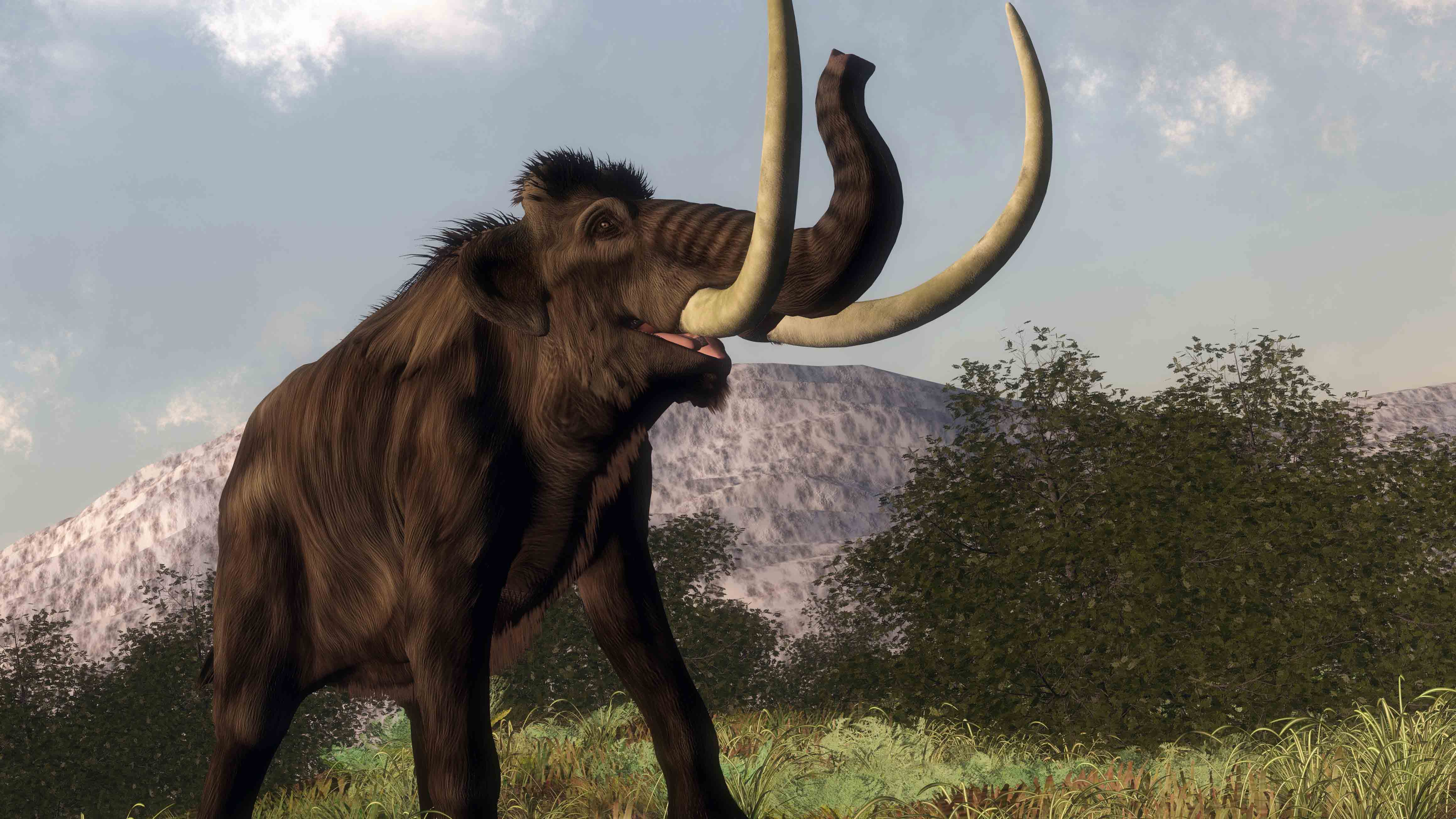A zoologist explains why the project to resurrect the woolly mammoth should go extinct

- Over the past couple of decades, a handful of de-extinction projects have explored the potential of “resurrecting” the woolly mammoth.
- The term is a bit misleading: Rather than resurrecting an extinct species, the process would essentially modify the genome of an existing species in order to give it traits an extinct species once possessed.
- The British zoologist Matthew Cobb argues that the primary focus of conservation efforts needs to be on the prevention of species loss, not on de-extinction.
The most truly god-like ability provided by genetic engineering is the apparent possibility of resurrecting extinct species – ‘de-extinction’. The most attention-grabbing proposal, which has been around for over a decade, is the idea of recreating the woolly mammoth, using our knowledge of the mammoth genome, obtained from tissue frozen in the tundra. It is claimed that de-extincting mammoths and other large tundra-dwelling mammals would not only enable us to encounter fantastic beasts but would also help mitigate some of the effects of climate change – as these creatures trampled and disturbed the ground, they would supposedly allow the winter frost to penetrate deeper, keeping carbon trapped for longer.
Leaving aside the obvious lessons of Jurassic Park, the technical issues involved in recreating a mammoth appear insurmountable. It would require taking the genome of the mammoth’s closest living relative – an Asian elephant – and introducing all the relevant changes (synthesising a whole chromosome is an incredibly arduous process and has not yet been performed in an animal; a woolly mammoth had twenty-nine pairs of chromosomes). These two species split between 2.5 and 5 million years ago; there are millions of base pairs that differ between them. Not all of those differences are significant, and we do not know which are the ones that count, but it is technically possible that all the relevant differences could be identified and then introduced into the elephant genome (the Asian elephant has one fewer pair of chromosomes than a mammoth, so the whole process might prove problematic).
Assuming these difficulties can be overcome, the modified chromosomes would then have to be introduced into an elephant cell and safely interact there with all of the cell’s organelles and molecules. But this cellular environment would be different in so many unknown ways to the cells that the mammoth genome co-evolved with that there is no guarantee that this would work. As an indication of the challenge involved, it took Venter’s group twenty years to master this procedure in a bacterial cell, which has only one chromosome and does not have a nucleus or any of the complex structures found in eukaryotes such as elephants and mammoths and does not develop into a large, hairy, intelligent animal.
Even if all this went smoothly, the resultant embryo would have to be implanted into a surrogate – again, an Asian elephant would be best – and the myriad interactions between embryo and mother would have to function appropriately for months and not kill either or both. This is much trickier than you might think – a few years ago a Spanish-led team of researchers tried to clone an extinct subspecies of Pyrenean ibex; hundreds of embryos were created and implanted in a series of surrogate mothers of the same species, but only one animal was born and she died a few minutes after birth. Things could so easily go awry using a surrogate from a different species.
Perhaps for this reason, one version of the project involves artificial wombs (these are currently hypothetical), like those in Brave New World, but which would presumably have to be the size of a small car. Finally, mammoths were not simply bags of cells and DNA, but complex social animals that lived in an environment that has now disappeared along with the cultural aspects of their social organisation. Even if every one of those unbelievably complex steps could be overcome, there would be profound ethical questions about the well-being of these extraordinary animals in the alien world in which they would find themselves.
As a result of these very real problems, the woolly mammoth de-extinction scheme, initially the brainchild of George Church, has recently become less mammoth in scope. The current version of the project, partly funded by Revive & Restore (R&R), a US foundation co-founded by Stewart Brand, focuses on identifying those alleles that adapted the mammoth to cold temperatures, with the dream of maybe some day creating an elephant with enough mammothy characteristics to enable it to live in northern climes. By 2022, a biotech start-up co-founded by Church called Colossal Biosciences had raised $75 million* to try to create a ‘cold-resistant elephant’, which it was claimed would be ‘functionally equivalent’ to a mammoth. So not a mammoth.
All these nuances were lost in the inevitable media excitement at the Colossal announcement, which yet again led to headlines about de-extincting mammoths (these have recurred every few years). Tori Herridge, a mammoth expert at the Natural History Museum in London, was invited to be involved but declined. She explained why in a thoughtful article in Nature:
Colossal has committed to ‘radical’ transparency, inclusion and community engagement, but has the chance to set the bar even higher, by empowering the public as part of its de-extinction journey. … The ethical road to de-extinction has to include informed citizen voices, alongside experts and activists. This might mean that the process takes longer than five years, but private enterprises working for the common good shouldn’t shy away from the views of those they seek to serve. Let the people decide the future world they want to build.
As evolutionary biologist and R&R board member Beth Shapiro explains in her best-selling if somewhat misleadingly titled How to Clone a Mammoth, it is extremely unlikely that we will ever truly recreate any extinct species, not only because it is technically extremely difficult, but also because the ecological relationships that made up their world have all been lost. In that respect, extinction is indeed forever.
Even more disturbing and god-like are the semi-serious, profoundly problematic proposals involving the recreation of Neanderthals – extinct humans who lived in Europe, Asia and the Middle East before us. Leaving aside some absurd internet fantasists, no scientist is actually considering such an experiment – cloning a Neanderthal and implanting the embryo in a surrogate human mother would be nauseatingly unethical on every level. However, researchers have studied the function of Neanderthal genes in human brain organoids – lentil-size blobs of tissue that can be grown in the laboratory from stem cells. A Neanderthal allele in a gene that plays a role in neural development and function altered the organisation and activity of otherwise human tissue. Brain organoid research is slightly creepy (they spontaneously grow eye-like structures that respond to light) as well as being a potential ethical minefield (could such a structure become even dimly conscious? How would we know?), but the researchers involved claim that this kind of study might shed light on how the functions of some of our genes may have differed in our close relatives.
Despite all the substantial technical and ethical issues relating to de-extinction, in 2014 the International Union for the Conservation of Nature set up a De-extinction Task Force which produced a set of guiding principles outlining the kind of detailed ecological and financial risk assessments that would be necessary before genetic engineering was applied to endangered or extinct species. In 2019, a subgroup of the Task Force published a positive exploration of the potential impact of genetic technology on conservation. At around the same time, ecologists from the University of California Santa Barbara and Imperial College took a far more cautious view, arguing that any de-extinction program should focus on recently extinct species (their ecology would be more likely to be intact) that could be restored in sufficient numbers to enable the recreation of their lost ecological function. That would rule out the mammoth, or a mammothified elephant.
What looks like a spiffy technofix might provoke excitement and attract funding from the public or mega-rich celebrities but is unlikely to be a solution to extinction for any but a tiny handful of cases. If molecular biology really must be employed, then scientists should try cloning dead members of an endangered species to increase genetic diversity, as has been done in the case of the US black-footed ferret, with funding from the R&R foundation. In 2022, an attempt to recover the genome of the extinct Christmas Island rat, using different extant rat genomes as models, showed that it was impossible to recover around 5 per cent of the genome, with over twenty genes being completely absent. Key genes involved in the sense of smell and the immune system were particularly affected.
De-extinction, if it is ever possible, will not be simple. The primary focus of conservation efforts needs to be on the prevention of species loss, not on de-extinction. In the vast majority of cases, that will involve basic work to prevent habitat degradation and to keep humans away from the endangered organisms. That might be less sexy, but it is a lot more sensible.





